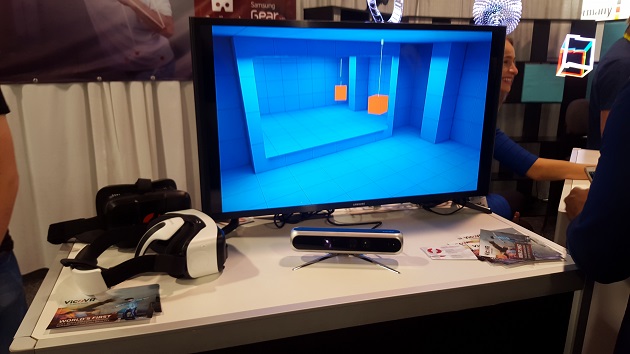There’re a lot of mobile head-mounted displays (HMDs) already on the market that allow easy affordable entry into the world of virtual reality (VR). Whether made out of cardboard or stronger plastic designs they are basic in design and allow head-tracking using a smartphones internal technology. But what about more immersive gameplay? If the headset has a head strap to free your hands then users will be able to use a number of different gamepads to help control their experience. Even that isn’t particularly immersive though, which is where VicoVR comes in. Developed by 3DiVi, VicoVR is a wireless VR sensor that enables full body motion control gaming in a virtual world.
At 3DiVi’s stand at the Consumer Electronic Show (CES) 2016 VicoVR was being demonstrated with a number of in-house designed titles to showcase the sensor. Slightly smaller in size than the Microsoft Kinect sensor, and with a sleeker curved design was easy to setup but it was required before every videogame.
The first title on test was a boxing simulator against a practice dummy. Instructed to hit each of the targets highlighted areas in succession, the training mode ran through basic boxing manoeuvres. Jabs to the face, crosses to the chest and hooks to the arms were all captured relatively well. Some practice was needed to get a feel for the control system becoming more intuitive with use. The tracking wasn’t precisely one-to-one, at times the movement was slightly jarring and inconsistent. After finishing the training you’re moved to a time attack mode were you utilise all the moves learned to punch the dummy and whittle down its health bar before the clock stops. This was definitely far more engaging and fun, and depending on the amount of effort put in a workout too.
The demo then moved onto a much more relaxing flying videogame, putting you in control of a soaring eagle. Bringing arms up to simulate wings the title had you flying on a linear path collecting blue oxygen bottles to increase range, whilst avoiding red floating mines which decreased the oxygen bar. Other various obstacles littered the path as the eagle flew through the clouds to try and reach the goal. Similar to the boxing the control isn’t instant with some latency noticeable but not detrimental. Leaning left and right steered the bird while leaning forward made it dive, flapping your arms naturally increased height without too much effort.
The last demo VRFocus tried involved a lot more precision that the previous two, revealing the potential of this prototype system but also its flaws. Developed by dkDev this was archery, a sport well suited to full-body motion control. Just as you would in real archery, your main hand draws the bow for power while the other moves the bow for aiming. For added realism players need to pick an arrow out of a quiver on their back in the exact same way, putting their arm behind their head and bringing it up.
With 50 levels to choose from there was plenty of scope for extended play although many may find the prospect of getting through all of them tiresome. The main issue was the aiming which felt wayward, the red targeting line which adjusted its downward curve depending on power was fine but trying to keep it on target another matter. Even without moving the bow arm the aiming would drift, so that you’d almost have to pre-empt every shot. This was made all the more difficult by the arrow only releasing when at maximum power, having to make sure the bow was correctly drawn but not too much before you’d finished aiming.
Despite these flaws the overall experience was fun and showed what could be done on a mobile headset platform. And as VicoVR is being developed to be compatible with many VR HMD systems it could well add some much needed depth and immersion to them when its released.
-END-
The post Hands-on with VicoVR appeared first on VRFocus.



![Insta360 X4 Video Compilation [No Talking]: 8K, Slow-Mo, Timelapse](https://news.lecce360.com/wp-content/uploads/2024/04/1713362788_maxresdefault-218x150.jpg)









![Insta360 X4 Video Compilation [No Talking]: 8K, Slow-Mo, Timelapse](https://news.lecce360.com/wp-content/uploads/2024/04/1713362788_maxresdefault-100x70.jpg)

